Filipino writing in English has a rich history, evolving from oral traditions to modern digital expressions. This transformation reflects the country’s cultural and historical journey. Early narratives were passed down through spoken word, preserving stories and values. Over time, writing became a powerful tool for sharing ideas and shaping identity.
The introduction of English in the Philippines, starting with the arrival of the Thomasites in 1901, marked a turning point. Schools and publications like The Filipino Students’ Magazine and The Philippines Herald played a key role in nurturing this new form of expression. Writers began to explore themes of society, politics, and culture, creating works that resonated with readers.
Today, Filipino writing in English continues to thrive, embracing digital platforms to reach a global audience. From novels to online articles, it remains a vital medium for storytelling and cultural exchange. This evolution highlights the adaptability and creativity of Filipino writers.
Key Takeaways
- Filipino writing in English evolved from oral traditions to digital forms.
- English was introduced in the Philippines through education in the early 1900s.
- Early publications helped shape the development of Filipino writing.
- Writing serves as a tool for cultural and historical expression.
- Modern Filipino writers use digital platforms to reach a global audience.
Historical Roots and Oral Traditions
Long before written texts, Filipinos relied on spoken word to preserve their history and values. Oral traditions were the backbone of storytelling, passing down myths, legends, and cultural wisdom from one generation to the next. These narratives were not just stories but a way to teach lessons, celebrate heroes, and strengthen community bonds.
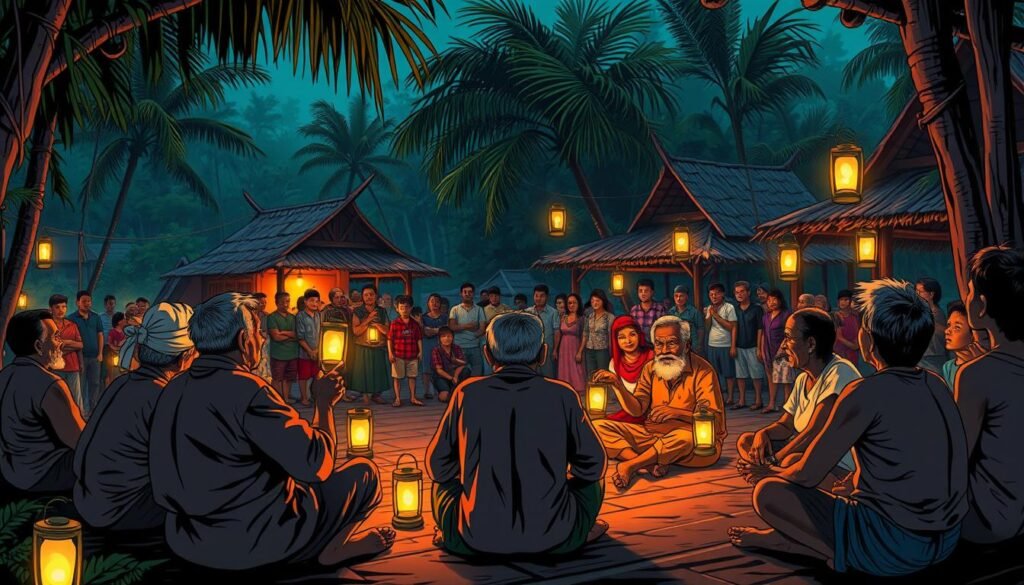
Origins of Oral Tradition in the Philippines
In ancient times, oral storytelling was the primary way to share knowledge. Communities gathered to listen to tales of gods, ancestors, and epic adventures. These stories were often accompanied by music, dance, and rituals, making them a vibrant part of daily life. Proverbs and riddles were also used to teach moral lessons and sharpen thinking skills.
Oral traditions were not just entertainment; they were a way to record history. Without written records, people relied on memory and repetition to keep their stories alive. This method ensured that important events and cultural values were preserved over time.
Transition from Oral to Written Works
As societies evolved, so did their methods of storytelling. The introduction of writing systems marked a turning point. Early Filipino authors began to transcribe oral narratives into written text, creating the first written records of their culture. This shift allowed stories to reach a wider audience and be preserved more accurately.
Books and manuscripts became new tools for sharing knowledge. Written works like the Hudhud and Biag ni Lam-ang are examples of how oral epics were transformed into literary masterpieces. This transition not only preserved stories but also laid the foundation for modern Filipino writing.
Cultural Forces Shaping the Filipino Literary Landscape
The Filipino literary landscape is deeply rooted in indigenous narratives and folklore, shaping its unique identity. These cultural forces have played a vital role in defining the themes, styles, and values found in modern Filipino writing. From ancient myths to regional practices, these elements continue to inspire writers and enrich their works.
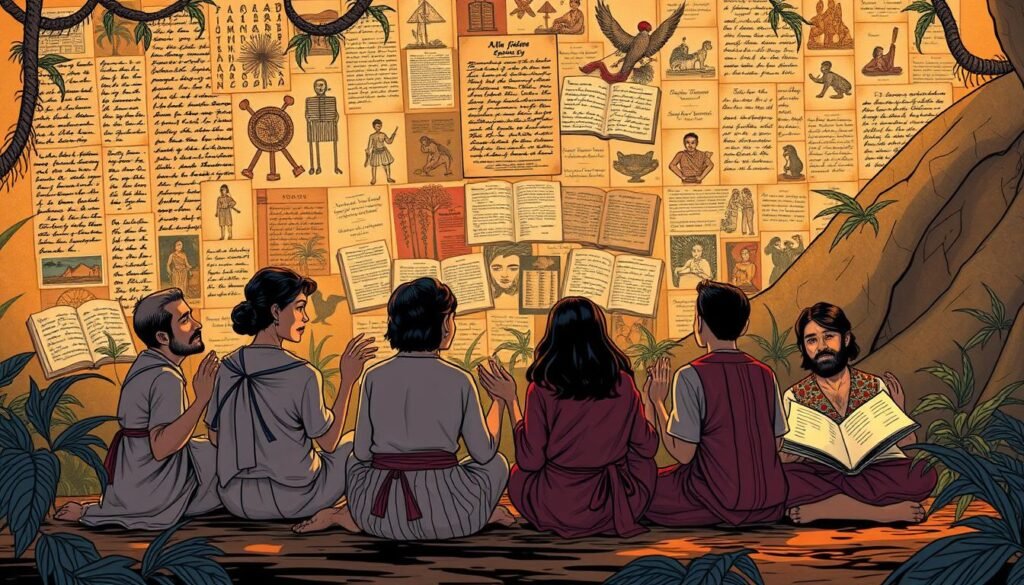
Integration of Indigenous Narratives and Folklore
Indigenous stories and traditions serve as the foundation of Filipino literary creativity. Myths, legends, and folktales passed down through generations are woven into the fabric of modern writing. These narratives often reflect the values, struggles, and aspirations of Filipino communities.
Writers play a crucial role in adopting and adapting these elements. By blending oral traditions with regional practices, they create texts with deep cultural resonance. This approach ensures that the subject matter remains relevant and meaningful to readers.
“Folklore is not just a collection of stories; it is the soul of a culture.”
Specific examples of folklore integration highlight this process. Works like the Hudhud and Biag ni Lam-ang demonstrate how traditional epics are transformed into literary masterpieces. These texts not only preserve cultural heritage but also offer a unique lens to study the evolution of Filipino writing.
- Indigenous narratives shape modern literary traditions.
- Oral traditions blend with regional practices and local languages.
- Writers adapt folklore to create culturally resonant texts.
- Examples like Hudhud showcase the integration of folklore.
- Cultural forces provide a unique perspective for critical analysis.
In conclusion, the integration of indigenous narratives and folklore is a defining feature of Filipino writing. These cultural forces not only preserve heritage but also inspire contemporary creativity. By studying these elements, we gain a deeper understanding of the Filipino literary landscape.
Colonization and Its Impact on Filipino English Literature
The colonial era played a pivotal role in reshaping Filipino writing, introducing new languages and literary forms. Both Spanish and American influences left a lasting mark on the country’s cultural and creative expressions. This period not only redefined the language of writing but also brought new themes and styles to the forefront.

American and Spanish Influences
The Spanish colonization, which lasted for over three centuries, introduced Catholicism and European literary traditions. Works from this era often reflected religious themes and moral lessons. In contrast, the American period in the early 20th century brought English education and Western literary trends. This dual influence created a unique blend of cultural and artistic expressions.
Writers began to explore themes of identity, resistance, and social change. The introduction of English as a medium allowed Filipino authors to reach a global audience. This shift marked a significant turning point in the review of literary development in the Philippines.
Emergence of English as a Medium
English became a key source of literary expression during the American colonial period. Schools and publications played a crucial role in promoting this new medium. Writers like José Garcia Villa and Nick Joaquin used English to craft works that resonated both locally and internationally.
Poetry, in particular, evolved under Western influences, blending traditional Filipino themes with modern styles. This period also saw the rise of literary criticism, providing a platform for deeper analysis of Filipino works. By the mid-20th century, English had firmly established itself as a dominant language in Filipino writing.
“Language is not just a tool for communication; it is a bridge between cultures and histories.”
In summary, colonization profoundly shaped Filipino writing, introducing new languages and literary forms. The dual influences of Spanish and American regimes created a rich tapestry of themes and styles. Today, this legacy continues to inspire writers and readers alike.
Filipino Literature: Pioneers and Visionaries
Pioneering Filipino writers have left an indelible mark on the nation’s literary heritage. Their works not only reflect the history and culture of the Philippines but also set benchmarks for quality and authenticity. These authors have shaped the body of Filipino writing, making it a vibrant and dynamic field of study.
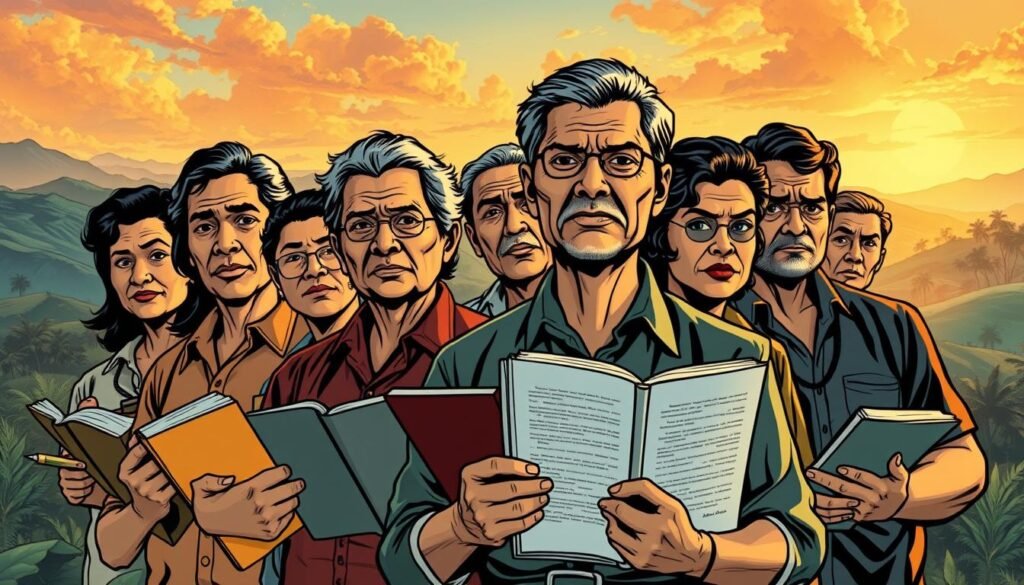
Key Authors and Literary Trailblazers
Filipino writing owes much to its trailblazers, who introduced innovative styles and themes. Writers like José Rizal, Nick Joaquin, and Wilfrido Nolledo are celebrated for their contributions. Their works, such as Noli Me Tangere and A Captive Splendor, remain iconic in the article of Philippine literature.
These authors used their craft to address social issues and national identity. Their narratives often blended traditional Filipino themes with modern storytelling techniques. This approach not only preserved cultural heritage but also inspired future generations of writers.
“A nation’s literature is a mirror of its soul, reflecting its struggles, dreams, and triumphs.”
Here’s a look at some of the most influential figures and their contributions:
| Author | Notable Work | Contribution |
|---|---|---|
| José Rizal | Noli Me Tangere | Spark for Filipino nationalism |
| Nick Joaquin | The Woman Who Had Two Navels | Exploration of identity and history |
| Wilfrido Nolledo | But for the Lovers | Innovative narrative techniques |
These authors not only enriched the literary landscape but also paved the way for modern Filipino writers. Their legacy continues to inspire, proving that literature is a powerful tool for cultural expression and social change.
Innovative Trends in Literature
Modern Filipino storytelling is undergoing a dynamic transformation, blending traditional techniques with cutting-edge innovations. Writers are exploring new ways to engage audiences, making literature more accessible and impactful. This shift is driven by advancements in technology and changing reader preferences.

Modern Narrative Techniques
Filipino authors are experimenting with innovative approaches to storytelling. Non-linear narratives, fragmented structures, and multiple perspectives are becoming more common. These techniques allow writers to explore complex themes in a way that resonates with modern readers.
Interactive storytelling is another emerging trend. Readers are no longer passive consumers but active participants in the narrative. This shift reflects the evolving role of the person in shaping literary experiences.
Digital Age Transformations
The digital age has revolutionized the way literature is created and consumed. Online platforms like Wattpad and Substack have given writers new opportunities to share their work. Multimedia formats, such as audiobooks and graphic novels, are also gaining popularity.
Theories of digital narrative highlight how technology is changing storytelling. Interactive fiction, transmedia storytelling, and virtual reality are redefining the boundaries of literature. These innovations are part of a broader trend toward immersive and engaging content.
“The digital age has turned readers into co-creators, blurring the lines between author and audience.”
Here are some key trends shaping modern Filipino writing:
- Non-linear and fragmented narratives.
- Interactive and participatory storytelling.
- Multimedia and transmedia formats.
- Theories of digital narrative and immersive experiences.
- The evolving role of the person in shaping literary paradigms.
These trends highlight the adaptability and creativity of Filipino writers. By embracing new techniques and technologies, they are redefining the way stories are told and experienced.
Recurring Themes and Narrative Styles in Filipino Works
Themes of national identity and social issues have long been central to Filipino storytelling. Writers use their craft to explore critical questions about society, politics, and culture. These recurring motifs not only reflect the nation’s struggles but also inspire readers to think deeply about their roles in shaping the future.
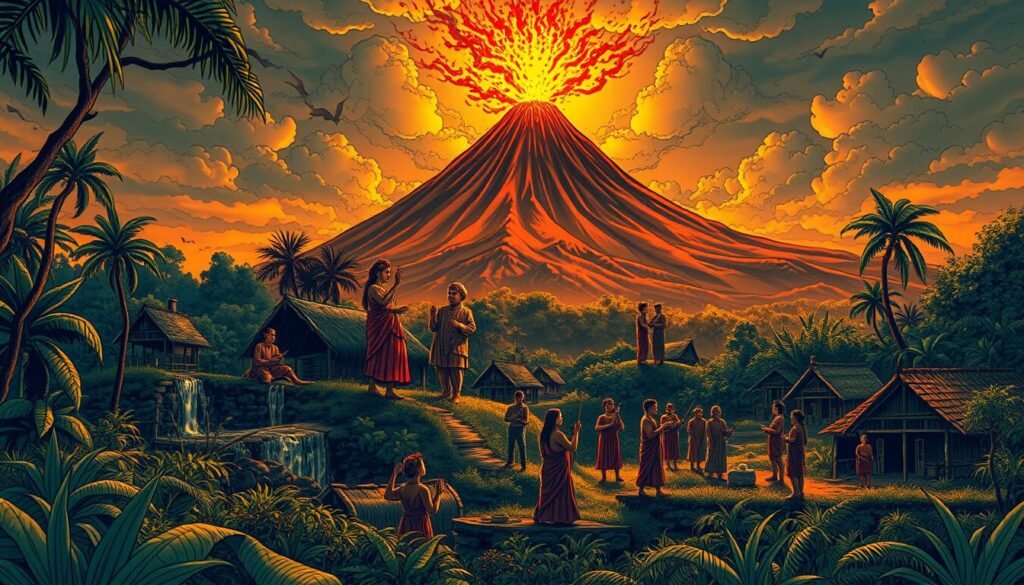
Filipino authors often address social concerns through their narratives. They use storytelling as a tool to highlight injustices and advocate for change. This approach makes their work both impactful and relatable to a wide audience.
National Identity and Social Issues
National identity is a recurring theme in Filipino writing. Authors explore what it means to be Filipino in a rapidly changing world. They delve into questions of heritage, tradition, and modernity, creating a rich tapestry of ideas that resonate with readers.
Social issues also take center stage in many works. Writers tackle topics like poverty, inequality, and corruption. These pieces often serve as a mirror to society, prompting readers to reflect on their own experiences and values.
“A writer’s duty is to ask the hard questions and challenge the status quo.”
Here are some key examples of works that exemplify these themes:
| Work | Author | Theme |
|---|---|---|
| Noli Me Tangere | José Rizal | National identity and resistance |
| Dekada ’70 | Lualhati Bautista | Social justice and activism |
| Ang Mga Kaibigan ni Mama Susan | Bob Ong | Cultural identity and modernity |
These works not only showcase the depth of Filipino writing but also highlight the importance of addressing societal questions. By examining these pieces, readers gain a deeper understanding of the ideas that have shaped the nation’s literary landscape.
For more insights into the evolution of Filipino writing, visit this page on the NCCA website. Additionally, explore the rich history of Philippine literature on Wikipedia.
Analysis of Influential Works and Key Examples
The evolution of Filipino writing in English is marked by influential works that have shaped the nation’s literary identity. These texts not only reflect the cultural and historical context of their time but also continue to inspire readers and writers alike. By examining these milestones, we gain a deeper understanding of the themes and techniques that define Filipino storytelling.
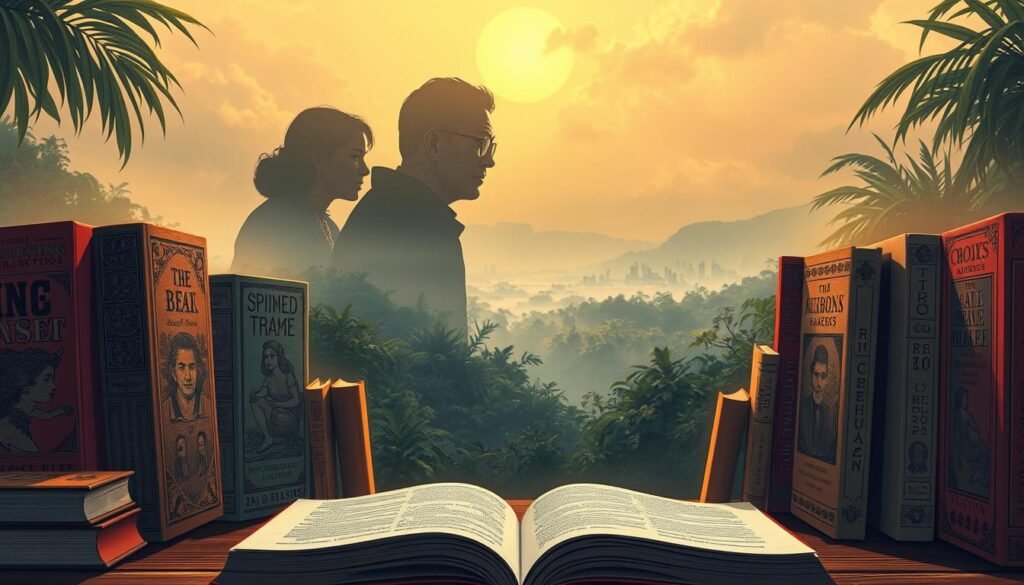
Case Studies of Literary Milestones
Landmark texts like Noli Me Tangere by José Rizal and The Woman Who Had Two Navels by Nick Joaquin are prime examples of how literature can shape a nation’s identity. These works explore themes of resistance, identity, and social justice, making them timeless pieces of art. They serve as a point of reference for understanding the struggles and aspirations of the Filipino people.
Another notable work is Dekada ’70 by Lualhati Bautista, which delves into the political turmoil of the 1970s. This novel provides a critical lens through which readers can examine the impact of historical events on individual lives. Such texts are not just stories but powerful tools for social commentary.
Review of Notable Literary Works
Filipino writing in English has produced works that resonate both locally and globally. For instance, Ang Mga Kaibigan ni Mama Susan by Bob Ong blends humor and horror to address cultural identity and modernity. This unique approach has made it a favorite among students and scholars alike.
Other works, like But for the Lovers by Wilfrido Nolledo, showcase innovative narrative techniques. These texts challenge traditional storytelling methods, offering fresh perspectives on familiar themes. They highlight the adaptability and creativity of Filipino writers in addressing complex issues.
“Literature is a mirror of society, reflecting its triumphs, struggles, and aspirations.”
Here’s a look at some key works and their contributions:
- Noli Me Tangere – A catalyst for Filipino nationalism.
- The Woman Who Had Two Navels – Exploration of identity and history.
- Dekada ’70 – A critique of political oppression.
- Ang Mga Kaibigan ni Mama Susan – A modern take on cultural identity.
These works not only enrich the Filipino literary canon but also serve as vital tools for understanding the complexities of Filipino society and its history. For more insights into influential works, visit this page on the OEDB website. Additionally, explore the rich history of Philippine literature on Britannica.
The Role of Literary Criticism and Analysis
Literary criticism serves as a bridge between readers and the deeper meanings within texts, offering insights that enrich understanding. It involves the interpretation, analysis, and evaluation of works, helping to uncover layers of meaning that might otherwise go unnoticed. This process not only enhances appreciation but also fosters a deeper connection between the reader and the text.
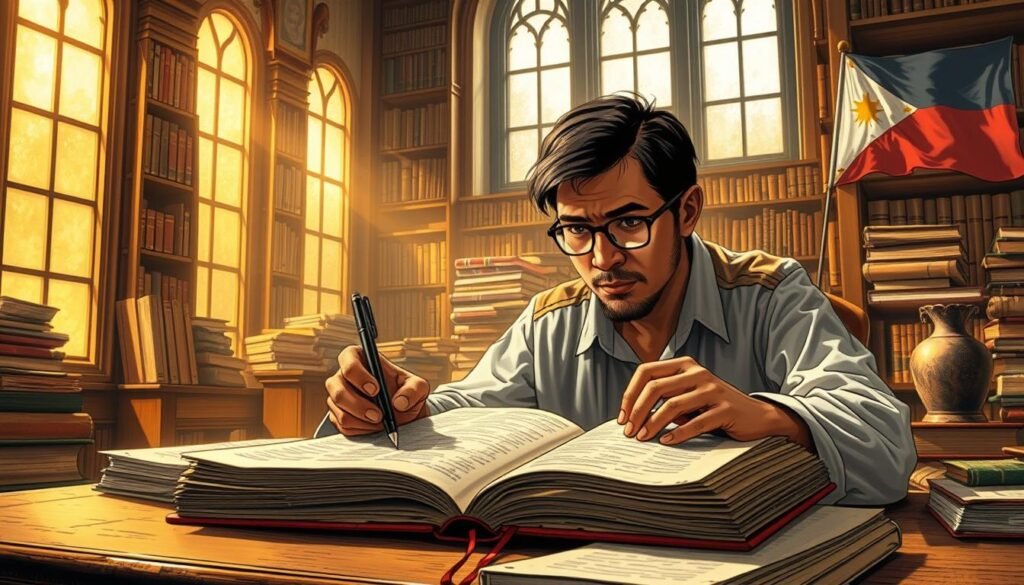
Evaluating Canonical vs. Contemporary Pieces
Critics often approach canonical and contemporary works differently. Canonical texts, like Noli Me Tangere, are evaluated based on their historical significance and enduring relevance. Contemporary pieces, on the other hand, are assessed for their innovation and reflection of modern issues. This dual approach ensures that both traditional and new voices are heard.
The form and structure of a work play a crucial role in its critique. Critics examine how the narrative is constructed, the use of language, and the effectiveness of the chosen genre. For example, in fiction, the plot, character development, and thematic depth are key areas of focus. These elements help determine the artistic merit of a piece.
“Criticism is not just about finding flaws; it’s about understanding the essence of a work and its impact on society.”
Here’s a comparison of how canonical and contemporary works are critiqued:
| Aspect | Canonical Works | Contemporary Works |
|---|---|---|
| Focus | Historical significance | Innovation and relevance |
| Criteria | Enduring themes | Modern issues |
| Evaluation | Impact on culture | Reflection of current society |
Literary criticism also influences public perception. Reviews and analyses can shape how a work is received, impacting its popularity and legacy. For more insights into the methodologies of literary criticism, visit this page on Grammarly’s blog.
In conclusion, literary criticism is a vital tool for understanding and appreciating texts. By examining both canonical and contemporary works, critics help readers navigate the complex world of literature, ensuring that its value is recognized and celebrated.
Future Directions in the Evolution of Filipino English Literature
The future of Filipino writing in English is being shaped by a blend of technology, global influences, and innovative storytelling techniques. As the literary landscape evolves, new voices and trends are emerging, redefining what it means to be a Filipino writer in the modern era.
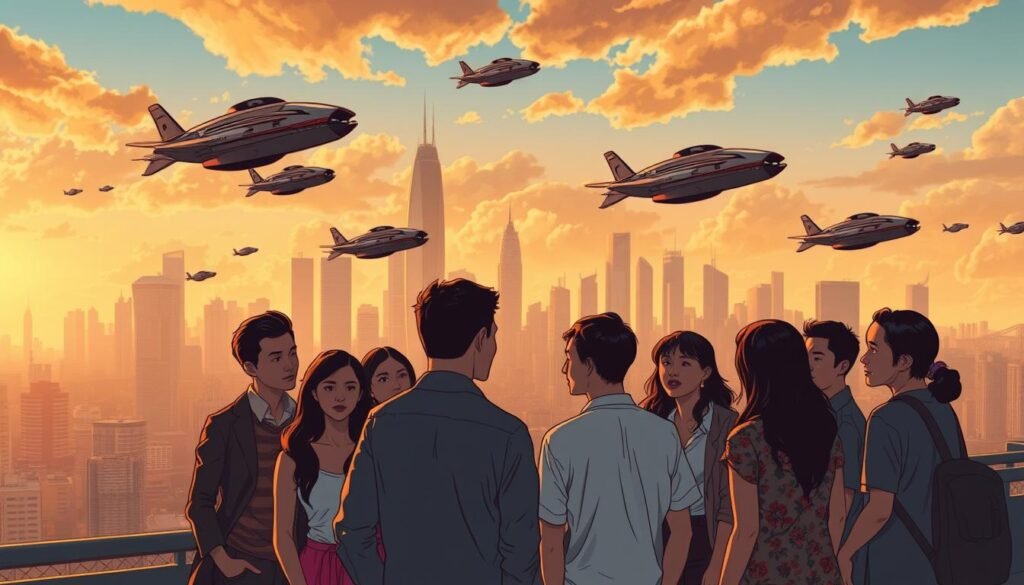
Emerging Voices and Trends
Modern technology and social media are playing a significant role in shaping the topics explored by Filipino writers. Platforms like Wattpad and Instagram are giving rise to a new generation of authors who experiment with novel narrative structures and multimedia formats. These writers are not only reaching local audiences but also gaining international recognition.
Global cultural exchanges are also influencing the science of storytelling. Filipino authors are drawing inspiration from diverse cultures, creating works that resonate with a broader audience. This cross-pollination of ideas is leading to the development of unique literary styles that blend traditional Filipino themes with contemporary global issues.
Sociocultural studies are providing valuable information on how literature reflects and shapes society. Writers are increasingly focusing on themes like identity, migration, and environmental concerns. These topics are not only relevant to Filipino readers but also address universal human experiences.
“The digital age has turned readers into co-creators, blurring the lines between author and audience.”
Here are some key trends shaping the future of Filipino writing:
- Interactive storytelling and multimedia formats.
- Exploration of global themes with a local perspective.
- Use of social media to connect with readers and build communities.
- Integration of scientific and sociocultural studies into narrative structures.
- Profiling of up-and-coming authors and their innovative experiments.
As the Filipino literary field continues to evolve, it faces both challenges and opportunities. Writers must navigate the complexities of the digital age while staying true to their cultural roots. By embracing these changes, they can create works that are not only relevant but also transformative.
For more insights into the evolution of Filipino writing, visit this page on the NCCA website.
Conclusion
Filipino storytelling in English has evolved into a vibrant medium of cultural expression, bridging tradition with modern discourse. From its historical roots to contemporary innovations, it reflects the dynamic life of a nation constantly reinventing itself. This section highlights how Filipino writers have adapted to changing times while preserving their cultural heritage.
The enduring tradition of storytelling continues to inspire new generations, particularly university students and literary enthusiasts. By exploring themes of identity and cultural integration, these works resonate with a diverse audience, fostering a deeper connection to Filipino values and experiences.
As we conclude, it’s essential to reflect on the role of storytelling in shaping societal narratives. For more insights on how to conclude your literature review, explore this resource. Filipino writing in English remains a testament to the power of creativity and cultural resilience.
FAQ
What are the historical roots of Filipino oral traditions?
Filipino oral traditions trace back to indigenous communities, where stories, myths, and folklore were passed down through generations via spoken word, songs, and rituals.
How did colonization influence Filipino literature in English?
Colonization, particularly by Spain and the U.S., introduced new languages and cultural elements. English became a dominant medium, shaping the themes and styles of Filipino literary works.
Who are some key pioneers in Filipino English literature?
Notable figures include Jose Garcia Villa, Nick Joaquin, and F. Sionil José, who played pivotal roles in shaping the literary landscape with their innovative works.
What themes are common in Filipino literature?
Recurring themes include national identity, social justice, and the struggle for independence, reflecting the country’s history and cultural struggles.
How has the digital age transformed Filipino literature?
The digital age has expanded access to literature through online platforms, enabling emerging writers to share their work and reach global audiences more easily.
What role does literary criticism play in Filipino literature?
Literary criticism helps evaluate both canonical and contemporary works, providing deeper insights into their cultural, historical, and artistic significance.
What are some notable works in Filipino English literature?
Influential works include “The Woman Who Had Two Navels” by Nick Joaquin and “Po-on” by F. Sionil José, which are celebrated for their narrative depth and cultural relevance.
How do modern narrative techniques differ in Filipino literature?
Modern techniques often blend traditional storytelling with experimental styles, addressing contemporary issues while preserving cultural heritage.
What are the future trends in Filipino English literature?
Emerging trends include diverse voices, digital storytelling, and a focus on global themes, reflecting the evolving identity of Filipino writers in a connected world.
Source Links
- Philippine Literature in English – National Commission for Culture and the Arts
- Philippine literature in English
- Oral literature | History, Characteristics & Types | Britannica
- Oral tradition | Storytelling, Cultural Preservation & Memory | Britannica
- Oral tradition
- The Spanish Influence on Filipino Culture and Language
- No title found
- The British Empire Imperialism Post-Colonialism Literature
- Silliman National Writers Workshop
- Great minds, visionary pens
- Jose Rizal’s Noli Me Tangere: the Novel That Sparked a Revolution – Pinas Culture
- What is Contemporary Literature? Latest Trends in Literature
- Exploring Current Trends in Literature and Their Impact on Readers and Writers – Creative Writing News
- Sino Ako? (Who am I?): Exploring Filipino American identity In Philippine Studies courses
- Edgar Allan Poe: Themes & Literary Analysis of Stories and Poems
- Popular literature | History, Definition, Examples, Books, & Facts | Britannica
- English literature | History, Authors, Books, Periods, & Facts | Britannica
- The Importance of Literary Criticism – Exeposé Online
- Literary criticism
- PHENOMENA
- LibGuides: How do I Write a Literature Review?: #5 Writing the Review
- What is the best way to conclude your literature review?

